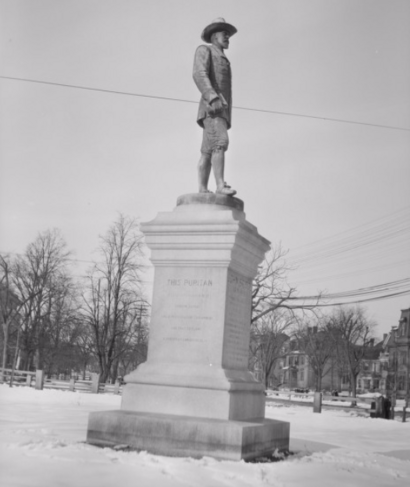Statue of John Bridge facts for kids
Quick facts for kids Statue of John Bridge |
|
|---|---|
 |
|
| Subject | John Bridge |
| Location | Cambridge Common, Cambridge, Massachusetts |
| 42°22′39″N 71°07′14″W / 42.377472°N 71.120556°W | |
The John Bridge Monument (also known as The Puritan) is a famous statue in Cambridge, Massachusetts. It stands in the northeast corner of the Cambridge Common. This statue honors John Bridge (1578–1665), an important early settler. The statue was a gift from Samuel James Bridge, who was a descendant of John Bridge. It was sculpted by Thomas R. Gould.
Contents
What Does the John Bridge Monument Look Like?
The statue of John Bridge is quite large. The figure itself is about nine feet tall. The stone base, called a pedestal, is also about nine feet tall. The entire statue weighs 1800 pounds.
The front of the statue's base has words carved into it. They tell us about John Bridge:
- JOHN BRIDGE 1578–1665
- He left Braintree, Essex County, England, in 1631.
- He came with Reverend Mr. Hooker's group.
- He settled here in 1632.
- He stayed when that group moved to Connecticut.
- He helped supervise the first public school in Cambridge in 1635.
- He was a selectman (a local government official) from 1635 to 1652.
- He was a church deacon from 1636 to 1658.
- He was a representative to the Great and General Court (a type of early government assembly) from 1637 to 1641.
- This group also asked him to plan out lands in this town and nearby.
The other three sides of the base also have important messages:
- THIS PURITAN helped to create a church, a school, and a representative government here. This helped to build a Christian community.
- The statue was put up and given to the city on September 20, 1882, by Samuel James Bridge. He was from the sixth generation after John Bridge.
- "They that wait upon the Lord shall renew their strength."
Who Was John Bridge?
John Bridge was born in Essex County, England, in 1578. He came to Cambridge in the 1630s. He was part of a group called the Braintree Company. John Bridge helped convince a minister named Thomas Shepard to come to Massachusetts.
When some settlers, led by Thomas Hooker, left Cambridge to go to Connecticut, John Bridge decided to stay. He was an important leader in the early community. He served many terms as a "selectman," which meant he helped manage the town. He also helped oversee the local school.
John Bridge passed away in 1665. He was buried in Harvard Square. Before the statue was built, Samuel J. Bridge placed special memorial stones over John Bridge's burial spot on July 4, 1876.
How the Monument Was Built
The John Bridge statue was officially dedicated on November 28, 1882. Samuel J. Bridge donated the statue. It was sculpted by Thomas R. Gould. When Thomas R. Gould passed away while working on it, his son, Marshall S. Gould, finished the project.
Samuel J. Bridge also donated another famous statue: the statue of John Harvard on Harvard University's campus. Samuel J. Bridge had an important job as an appraiser, first in Boston and later in San Francisco.
The dedication ceremony for the John Bridge Monument took place at Shepard Memorial Church. Many people spoke at the event. Thomas Wentworth Higginson, a famous writer, spoke about the statue. He said it was special because it showed "the common man." He even thought it was the first time an "every-day Puritan" was shown in a sculpture.
The president of Harvard, Charles William Eliot, also spoke. He praised John Bridge's life. He said Bridge's life showed what the lives of millions of people who would later build up the wild continent would be like. At the time, some people believed this was the first statue of a Puritan pioneer in New England. A special plaque honoring Bridge was also placed in Shepard Memorial Church.
Times the Statue Fell Over
The John Bridge statue has been knocked over a few times. In 1922, people found the statue with a rope around its neck. Newspapers thought that "college boys or other young men of Cambridge" might have done it. In 1935, it was found toppled again, this time with wire around its neck. It took several weeks to put it back up.

